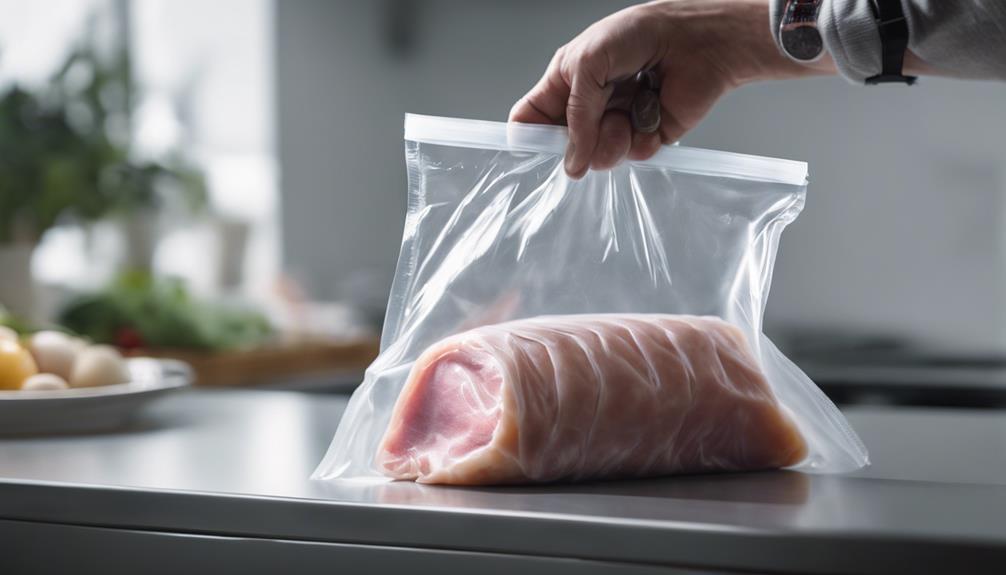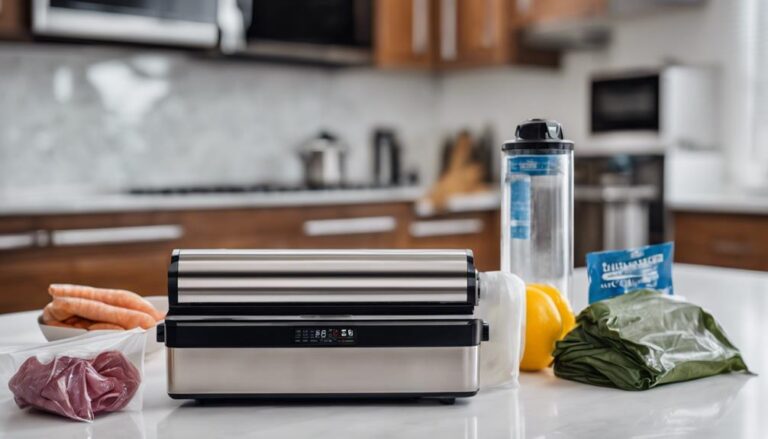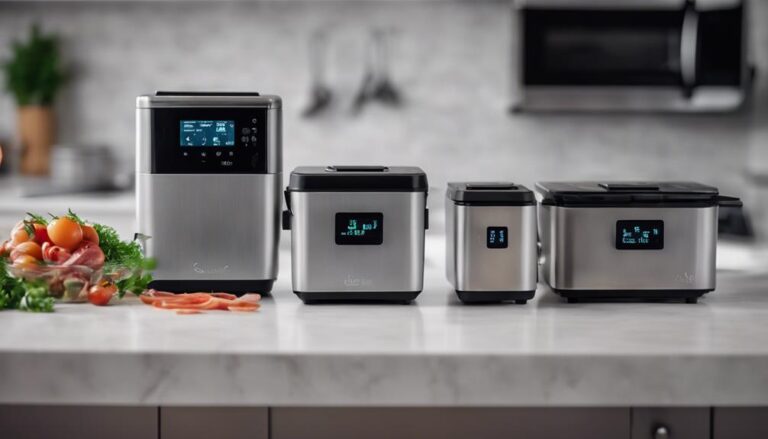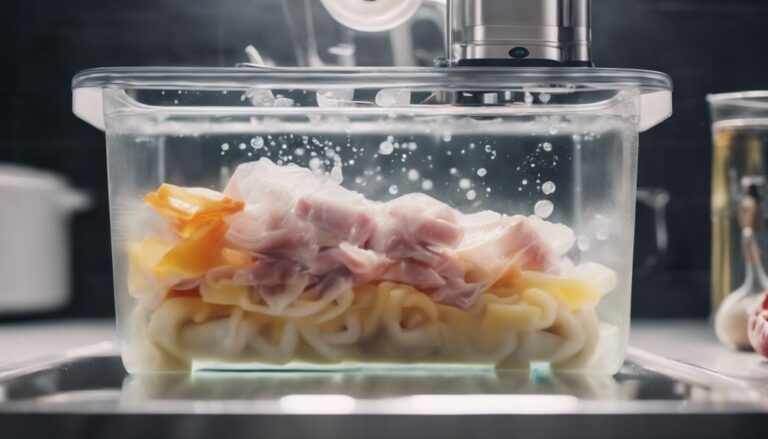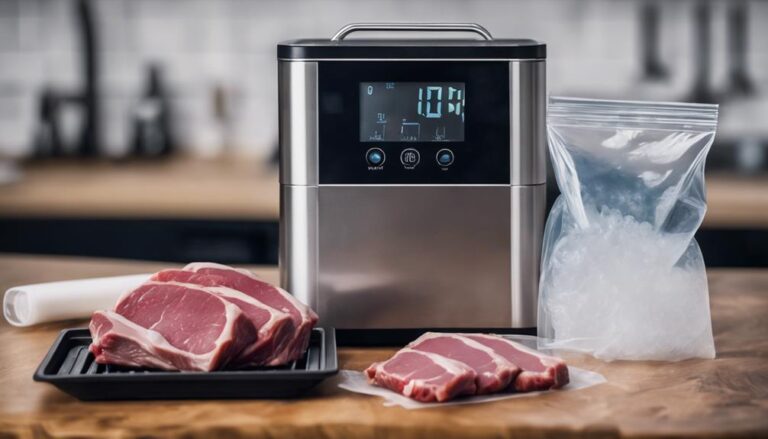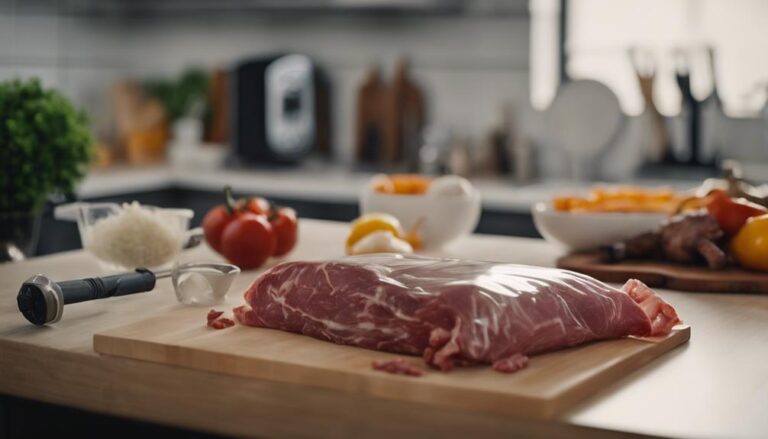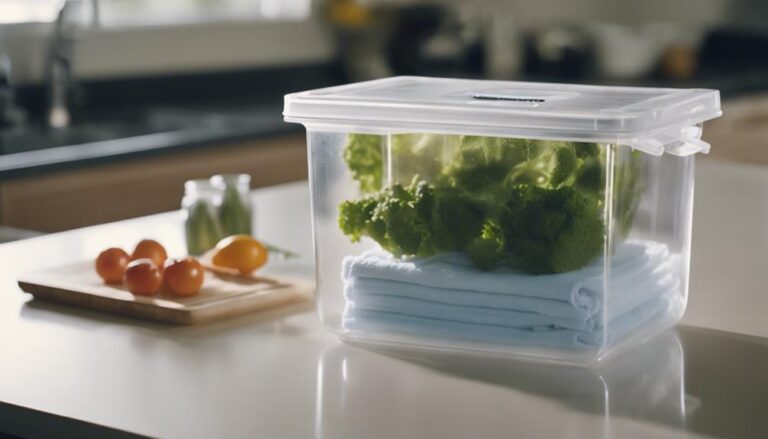Navigating the Do's and Don'ts of Sous Vide Bags
When it comes to sous vide bags, go for food-grade silicone for safety and freshness. Opt for BPA-free options to keep things sustainable. Seal your bags tight to avoid leaks—nobody wants a watery mess. Be mindful of temperature limits; you don't want to push those bags too far. Store them cool, dry, and labeled for a stress-free cooking experience. Quality bags equal fewer mishaps and tastier meals. Think about the environment, consider reusable bags for a greener approach. Remember, safety first with food-safe bags and proper cleaning. Bag up these tips for sous vide success.
What You Will Learn Here
- Choose food-grade silicone bags for safety and durability.
- Properly seal bags using the water displacement method.
- Avoid BPA and opt for reusable, eco-friendly options.
- Check temperature limits for safe sous vide cooking.
- Store bags in a cool, dry place and label for easy identification.
Importance of Sous Vide-Safe Bags
When it comes to sous vide cooking, the importance of using sous vide-safe bags can't be overstated. These bags are like the unsung heroes of your culinary adventures, keeping your food safe from any unwanted chemicals that could sneak into your meal. Made from high-quality materials like food-grade silicone, these bags are the VIP protection your food needs. You wouldn't want any uninvited plastic chemicals crashing your sous vide party, right?
Imagine your food cozying up in a safe, airtight environment – just like chilling in a food-grade silicone fortress. These bags not only shield your meals from harmful substances but also make sure everything stays fresh and delicious. Plus, they're airtight champs, helping you create that perfect vacuum seal for your sous vide wizardry. So, always remember, when it comes to sous vide, stick with bags that are labeled as safe for the job. Your taste buds will thank you for it!
Choosing the Right Material
When choosing the right material for your sous vide bags, consider the options available, the durability factors, and safety considerations.
Silicone bags, like the popular Stasher bags, offer a reusable and eco-friendly choice that guarantees longevity in your cooking adventures.
Opting for BPA-free silicone means you're not just cooking, you're making a sustainable statement in the kitchen!
Material Options
To guarantee successful sous vide cooking, choosing the appropriate material for your bags is vital for preserving food safety and achieving ideal results.
When it comes to material options for your sous vide adventures, you have a few choices to ponder. Silicone bags are a fantastic option, durable and reusable, which means no more single-use plastic waste cluttering up your kitchen.
Vacuum-sealed bags are like the superheroes of sous vide, keeping water out and sealing in all the flavors. BPA-free plastic bags are another safe bet, offering convenience without any harmful chemicals.
And let's not forget about freezer-safe zip bags, a cost-effective solution that's easy to find.
Durability Factors
Consider the durability of your sous vide bags by selecting materials designed to withstand the rigors of sous vide cooking, guaranteeing a successful culinary experience. Silicone sous vide bags are a top choice for durability, allowing for multiple uses and reducing waste.
Opt for high-quality vacuum-sealed bags made of BPA-free materials to make sure they hold up well during the cooking process. Seek out bags specifically crafted for sous vide, with robust seals that keep your ingredients secure and your water bath tidy.
While freezer-safe ziplock bags can be a pocket-friendly alternative, they may not endure multiple rounds of cooking. Remember, always go for sous vide bags made of food-grade, heat-resistant materials for a reliable cooking companion.
Safety Considerations
For durable and safe sous vide bags, prioritize selecting materials that are specifically designed for high-temperature cooking applications, guaranteeing a secure cooking experience.
When considering safety in sous vide cooking, remember these key points:
- Choose sous vide-safe bags made of food-grade materials like BPA-free plastic or silicone to ensure your food stays tasty and safe.
- Look for bags labeled as suitable for sous vide cooking to avoid any kitchen mishaps (nobody wants a bag that can't stand the heat!).
- Avoid regular plastic bags that mightn't handle the sizzle; opt for bags that are designed to handle the heat like a pro.
Proper Bag Sealing Techniques
Imagine this: you've got your seasoned steak snugly tucked into a sous vide bag, ready to be cooked to perfection. Before sealing the deal, quite literally, make sure to get rid of any pesky air lingering in there.
The water displacement method is your trusty sidekick here. Just lower the bag into a tub of water, allowing the pressure to push out all the air like it's a game of culinary whack-a-mole. Once you're satisfied that your bag is air-free, seal it up like you're preserving a precious secret (which, in this case, is your delicious meal).
Give it a gentle squeeze to confirm that seal is airtight; you don't want any leaky surprises during cooking. And hey, investing in a good vacuum sealer can make this whole process smoother than a jazz saxophonist on a lazy Sunday afternoon.
Avoiding Chemical Contamination
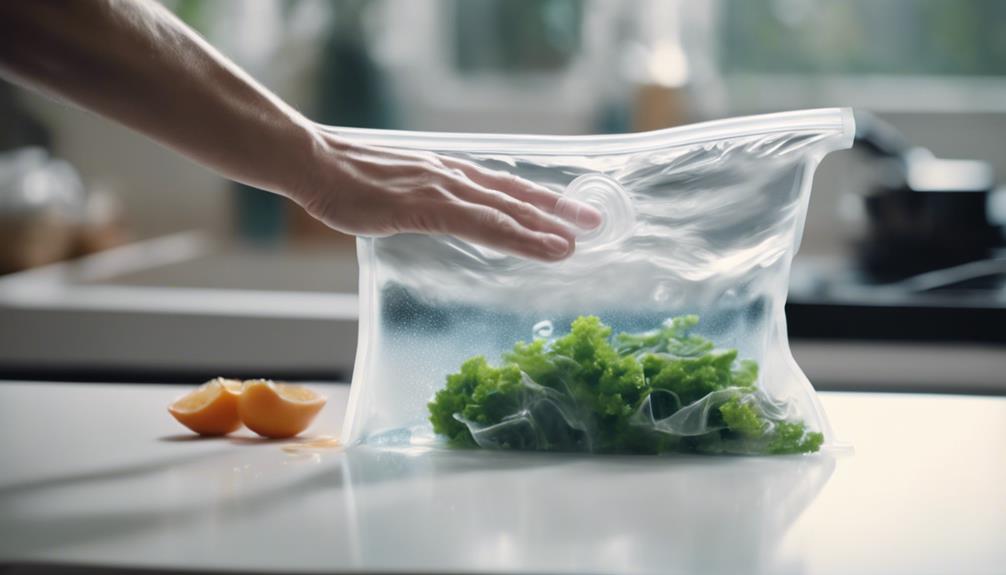
To guarantee the safety of your sous vide cooking, prioritize using food-grade plastic bags like polyethylene to avoid chemical contamination. When it comes to your culinary creations, you want to savor the flavors without any unwanted additives sneaking in. Here's how to keep it clean and tasty:
- Sous Vide-Safe Materials: Opt for sous vide-safe bags made from food-grade plastics like polyethylene. These materials are designed to withstand the gentle cooking process without leaching harmful chemicals into your meal.
- Avoid Harmful Additives: Steer clear of bags containing chemicals like BPA or phthalates. Freezer-safe zip bags are a popular choice for sous vide cooking as they're free from these nasties, ensuring your food stays pure and delicious.
- Silicone Solutions: Consider reusable silicone bags as another sous vide-safe option. These bags are free from harmful additives and chemicals, providing a sustainable and safe cooking vessel for your culinary adventures. Keep it clean, keep it safe, and enjoy your sous vide journey!
Understanding Bag Temperature Limits
Hey there, ready to tackle the hot topic of bag temperature limits in sous vide cooking?
When it comes to these bags, think of them like your best pal – reliable within their limits but mightn't handle it well if things get too hot!
Remember, exceeding those temperature boundaries can turn your bag into a gooey mess or even release not-so-tasty chemicals into your meal.
Bag Material Types
Exploring the world of sous vide cooking, understanding the temperature limits of different bag material types is essential for safe and efficient meal preparation. When it comes to sous vide bags, plastic materials like polyethylene or polypropylene are the stars of the show. Here's what you need to know:
- BPA-Free Plastic: Sous vide bags are typically made of BPA-free plastic materials, ensuring your meals stay chemical-free.
- High Heat Tolerance: These bags can handle temperatures up to 195°F (90°C) and above, keeping your cooking safe and sound.
- Heat-Safe Labels: Look out for bags specifically labeled as heat-safe for sous vide cooking to avoid any kitchen mishaps.
Temperature Safety Guidelines
Understanding the temperature limits of sous vide bags is important for ensuring safe and effective cooking practices. Sous vide bags usually hold up well at temperatures of up to 195°F (90.6°C) for extended cooking periods. Going beyond this limit risks bag meltage or worse, chemical leakage – no one wants a side of plastic with their steak! Most sous vide recipes fall within a cozy 120-185°F (48.9-85°C) range, keeping your food both tasty and safe. Stick to the bag's recommended temperature range to avoid mishaps like bag deformities or unwanted food guests. So, remember, keep it cool (or hot, within limits) for a sous vide experience that's all about the flavor, not the drama.
| Sous Vide Bags | Temperature Limits |
|---|---|
| Safe up to 195°F (90.6°C) | Avoid melting or chemicals leaching |
| Optimal range 120-185°F (48.9-85°C) | Ensures food safety and quality |
| Stick to recommended range | Prevents bag deformities and food contamination |
Risks of Reusing Improper Bags
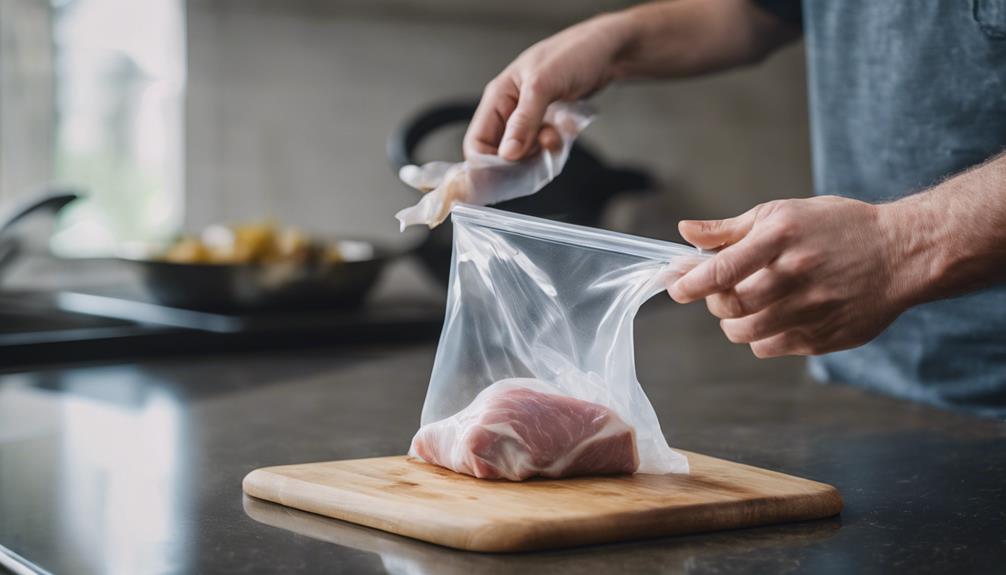
Reusing non-sous vide safe bags poses a significant risk of chemical leaching into your food. When it comes to sous vide bags, you want to keep things clean and safe. Here are three reasons why using improper bags is a big no-no:
- Chemical Leaching: Improper bags can release harmful chemicals into your food when exposed to heat during the sous vide cooking process. Your meal shouldn't come with a side of mystery chemicals!
- Compromised Food Safety: Using the wrong bags can compromise the safety and quality of your dish. Your taste buds deserve better than a risky culinary adventure!
- Bacterial Contamination: Reusing bags that aren't meant for sous vide can harbor bacteria from previous use, putting you at risk of food contamination. Nobody wants unexpected guests at their dinner party!
Storage and Handling Tips
For best storage and handling of sous vide bags, make sure you store them in a cool, dry place away from direct sunlight to preserve quality and prevent damage. Remember, these bags are like your delicate kitchen treasures, so treat them with care! Here's a handy table to guide you on how to store and handle your sous vide bags properly:
| Storage and Handling Tips | Description |
|---|---|
| Keep it Cool and Dry | Store in a cool, dry spot away from sunlight to maintain quality and prevent any mishaps. |
| Clean Hands for Safety | Handle with clean hands to ensure food safety and avoid any unwanted contamination issues. |
| Label and Date | Properly label bags with contents and date so you can track how long they've been hanging out. |
Impact of Bag Quality on Results
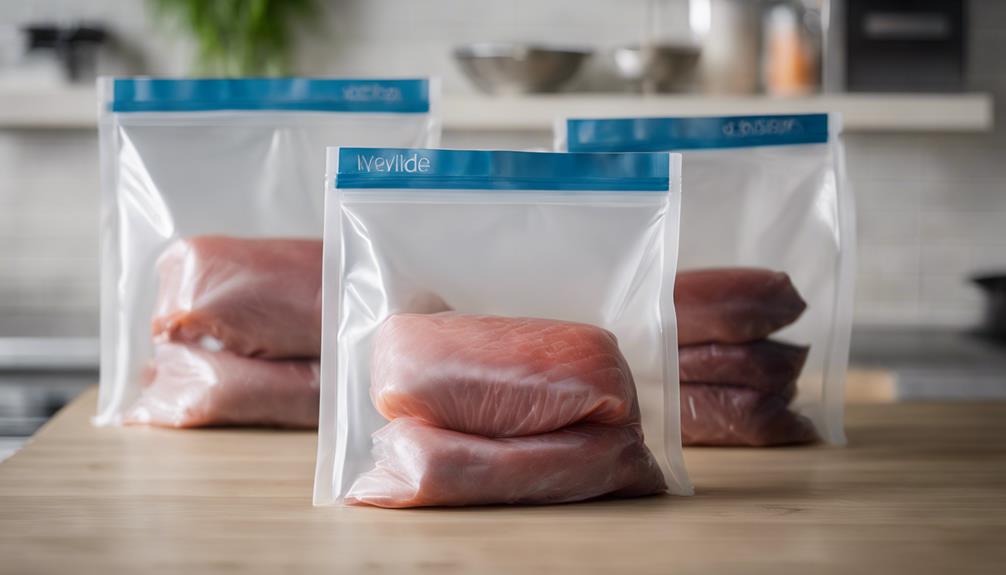
When it comes to sous vide cooking, the quality of your bags can make or break your dish.
Bag material matters more than you might think, ensuring your food stays moist and delicious.
Seal importance is vital; you don't want any unwanted water sneaking into your perfectly prepared meal!
Bag Material Matters
Why is the quality of sous vide bags important when cooking for best results? Well, let's spill the beans – or rather, keep them sealed tight! Here's why bag material matters:
- Leak Prevention: High-quality sous vide bags made from food-grade materials prevent leaks, ensuring your meal stays in the bag and not in the water.
- Safety First: Opt for BPA-free and food-grade sous vide bags to cook safely at low temperatures without any harmful chemicals leaching into your food.
- Flavor Saver: Quality bags help lock in the flavors, textures, and nutrients of your dish, ensuring a delicious outcome every time. So, bag your ingredients wisely for a superb sous vide experience!
Seal Quality Importance
Considering the significance of maintaining a robust seal on your sous vide bags, it becomes evident that this aspect plays a pivotal role in determining the success of your cooking endeavors.
Imagine this: a weak seal letting water sneak in, turning your perfectly seasoned dish into a bland, diluted mess. No one wants soggy steak or watery veggies, right?
A high-quality seal keeps everything snug and secure, ensuring your food cooks evenly and stays flavorful. Investing in quality sous vide bags with killer sealing abilities is like giving your dinner the VIP treatment it deserves.
Environmental Considerations
To minimize the environmental impact of sous vide cooking, consider switching to reusable silicone bags as a sustainable alternative to single-use plastic bags. Here are some tips to help you make greener choices when it comes to your sous vide bags:
- Opt for Reusable Silicone: Investing in reusable silicone bags not only reduces your plastic waste but also allows you to enjoy sous vide cooking without harming the environment.
- Proper Disposal Matters: When using plastic bags, make sure to dispose of them responsibly to prevent pollution and harm to wildlife.
- Explore Biodegradable Options: Consider using biodegradable material bags for sous vide cooking to further lessen your ecological footprint.
Safety Precautions for Sous Vide Bags
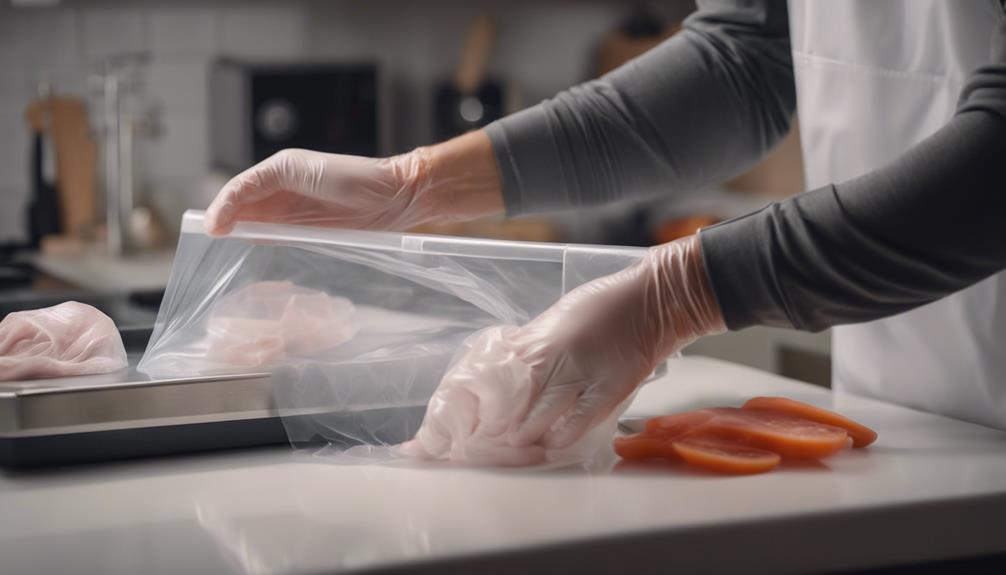
Make sure you use food-safe plastic bags specifically designed for sous vide cooking to safeguard against harmful chemicals leaching into your food. When diving into the world of sous vide, your choice of bags can make a big difference in food safety.
Opt for bags labeled as freezer-safe to handle the low cooking temperatures typical in sous vide. It's like giving your food a cozy winter jacket for its sous vide adventure.
Remember, once a bag has housed raw meat, it's best to bid it farewell to prevent any unwanted foodborne illnesses from crashing your culinary party.
After enjoying a delicious sous vide meal, show your bags some love by thoroughly cleaning and sanitizing them for their next cooking escapade.
To avoid any mix-ups in your sous vide process, always label your bags with contents and cooking instructions. Think of it as giving your bags a little ID card so they know exactly where they belong in your culinary lineup.
Stay safe, stay savvy with your sous vide bags!
Frequently Asked Questions
Is It OK to Have Some Air in Sous Vide Bag?
Having air pockets in your sous vide bag is not optimal. To solve this, vacuum seal your bag to enjoy the advantages of improved heat transfer and consistent cooking. Removing air guarantees proper immersion, maximizing food-water contact.
What Not to Do With a Sous Vide?
When it comes to sous vide safety, remember to follow proper sealing techniques. Avoid using non-sous vide safe bags, reusing bags from raw meat, overfilling bags, and using damaged bags. Protect your food and enjoy safe cooking.
Can You Leave Meat in Sous Vide Bag After Cooking?
You can safely leave meat in a sous vide bag after cooking. This helps retain juiciness and tenderness. Properly sealed bags maintain flavors and allow for convenient storage in the fridge or freezer. Enjoy delicious meals with ease.
Is It Bad to Sous Vide in Ziploc Bags?
When sous vide cooking, it's not bad to use Ziploc bags as long as they're freezer-safe. Yet, exploring alternative materials is wise for safety and environmental impact. Guarantee durability and proper seals to avoid risks.
Conclusion
So there you have it, folks! Remember, when it comes to sous vide bags, safety first! Choose the right material, seal them up tight, and watch out for any chemical nasties.
Keep an eye on those temperature limits, store them properly, and never underestimate the impact of bag quality on your cooking. And hey, let's not forget about the environment – go green with reusable bags!
Stay safe, stay savvy, and happy sous vide-ing!
